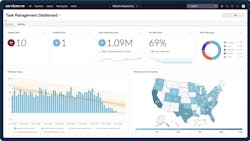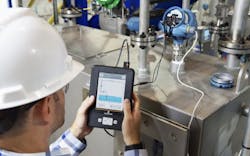Building resiliency into manufacturing operations is more important than ever. “Supply-and-demand volatility is becoming the norm,” said Pascal Brosset, global lead for production and operations at Accenture Industry X, a global consulting firm. “Manufacturers keep facing economic and geopolitical challenges that are very different from those they faced in the past.”
Challenges like the COVID pandemic, the Red Sea crisis, ransomware attacks and a growing shortage of skilled workers have revealed just how vulnerable manufacturers are to disruptions in their engineering, manufacturing and supply chain operations. “Our research shows that manufacturers lost $1.6 trillion in additional revenue growth annually in 2021 and 2022 due to such disruptions,” Brosset said.
Not only can the events causing these losses take manufacturers by surprise, but they can also leave lasting scars. “If a supplier can’t rebound quickly from a setback, its customers may move to another supplier,” noted Nina Golder, vice president of global lifecycle services at industrial automation supplier Emerson. “More disastrously for suppliers, customers may even redesign its product to eliminate that component, effectively designing the supplier out of the value chain. The pace of technology today has made these transitions and redesigns much easier.”
To weather such storms, manufacturers need to find ways to boost the resiliency of their operations. They need to implement strategies and deploy technologies that will boost their ability to minimize the effects of disruptions and maximize continuity and efficiency of operations during crises.
“There’s every reason for manufacturers to look at resilience afresh,” said Vasant Balasubramanian, vice president and general manager of risk and ESG at software supplier ServiceNow. The interconnectedness, complexity and scale of systems create more fragile environments. “For example, connected devices on the shop floor can greatly expand the attack surface for a hacker and shut down a company’s operations in a ransomware attack. The digital factory also creates more inter-dependencies between technology and operating equipment. This translates into efficiency gains when both are running smoothly and greater impact on customers when problems inevitably occur.”
Strategies and technologies for making these systems more resilient cannot be the short-term fixes that some manufacturers have hastily applied to complex global production and supply networks designed for cost efficiency and just-in-time deliveries. Rather, these strategies and technologies need to be long-term fixes that allow manufacturers to redesign their operations and supply chains to be agile, according to Brosset.
Resilience stems from agility
Boosting resilience begins with an agile and balanced supply chain. “Manufacturers should audit their supply chains to determine whether their suppliers are spread out across multiple world areas or are concentrated into one,” advised Golder. “If all your suppliers are concentrated in one place, you might quickly run into problems if that area of the world has a crisis.”
Consequently, she recommends having multiple suppliers wherever possible to mitigate this risk.
A related issue is striking a balance between global and local suppliers. “When time is of the essence, close proximity can make a difference,” said Golder. “It’s a critical component of optimizing cost, speed and efficiency.”
Indeed, an increasing number of manufacturers are taking advantage of both regional suppliers and regional production, according to “Resiliency in the Making,” a study conducted by Accenture last year. By 2026, 65% of the responding manufacturers intend to buy most of their key raw materials and other resources from regional suppliers, a proportion that has increased significantly from 38% in 2023. Even more manufacturers, 85%, plan to produce and sell most of their products in the same region by 2026, a number that is nearly double the 43% reported in 2023.
As important as balancing global and local suppliers and production sites is to mitigating the effect of disruptions, it is insufficient for sustained resilience. “Designing agility into operations is also necessary,” said Brosset. This begins with avoiding the use of single-source components whenever possible, but it also includes reconfigurable production facilities and event-based production management.
Generating this kind of agility requires the right level of automation. Brosset believes that investments in data, artificial intelligence and digital twins can help with building reconfigurable supply chains and manufacturing operations. “They enable real-time evaluation of disruptions; support real-time, data-driven decisions at all levels of the organization; and allow companies to adapt faster to sudden changes,” he said.
This kind of resilience also supports replicating operations elsewhere—an ability that does more than just help a manufacturer survive a sudden crisis. “It’s also an opportunity for growth,” argued Balasubramanian. “The ability to bring new lines online quickly and reliably could help you to pivot production lines quickly to meet changing demands that open new markets and customer segments.”
Intelligent systems can also streamline the implementation of best practices. “Plants need ways to capture tribal knowledge,” said Golder. “As people with decades of experience retire, teams need to ensure the best practices those people created are locked in and usable by the new personnel coming into the plant.” This has become increasingly important as the pool of experienced personnel shrinks.
Technology’s role in resiliency
A plan for deploying technologies to mitigate the effect of disruptions should contain at least the following four steps:
- The first is establishing visibility. “It’s difficult, if not impossible, to manage what you don’t know,” noted Balasubramanian. “Resilience must begin with a credible list of assets: connected devices, technology hardware and operating equipment.”
- Context is the second step needed to connect assets to business processes because it allows manufacturers to rank the risks to business processes. Consider two manufacturing lines—one producing parts in large volumes and the other producing them in small lots. “Once you quantify the cost of downtime for each line, you can decide what recovery time you can afford for each,” explained Balasubramanian. “Should there be a flood or outage, you can know in advance where to concentrate your response to minimize the impact on the business.”
- Context allows for the third step, scenario planning and testing. Planners should ask, what could go wrong for each asset or service, and how would these problems affect operations? What if no one can get to the plant? What are your options for remote operations and recovery? Be sure to consider all causes of disruptions, including those caused by such events as shortages, extreme weather, and cyber attacks.
- The last step is to exploit digitalization. “Having a team of digitally enabled workers capable of adjusting to new challenges is crucial when preparing for disruption,” said Balasubramanian. “Digitizing processes and giving workers personalized checklists to solve even the hardest problems not only supports uptime, but also democratizes knowledge. It makes every employee more productive, safe and prepared.” Therefore, he urges employers not only to give workers these tools, but also failsafe backups and offline access that will allow them to use them even when there is no power or network connectivity.
Heineken’s example
To show the power of digitalization, Balasubramanian pointed to a digitalization project at Heineken, which produces 188 million hectoliters of beer annually at 165 breweries in more than 70 countries. Its longstanding paper-based system had proven to be inadequate for managing the vast supply chain and equipment needed to ensure a steady supply of beer. The lack of a standard means for sharing knowledge and the diversity and scale of Heineken’s operations complicated the quick resolution of incidents and the performance of maintenance, risking downtime and productivity losses.
To avoid these problems, Heineken implemented a mobile-based custom app crafted by ServiceNow to streamline incident management and maintenance. “This app provides engineers with quick access to detailed information on incidents and tasks and offers real-time guidance through features like photos and design drawings,” said Balasubramanian. “It even supports offline functionality for areas with poor connectivity.” Besides streamlining problem solving, these features also enhanced the overall resilience of its operations by using historical data for predictive maintenance and by offering tailored support immediately to engineers on the ground.
Creating autonomous processes
Another strategy for improving a company’s resilience is to upgrade operations that are merely automated, transforming them into autonomous operations. “As industrial plants integrate more advanced technologies, the sheer amount of data and complexity can become overwhelming for the existing staff,” said Monil Malhotra, vice president of industrial software at Emerson. “Autonomous operations are founded in technologies that can predict when something will go wrong.”
These technologies help the staff cope with the large volumes of data generated by automation today and to use that data to keep processes running smoothly at the established performance benchmarks. In these operations, data typically moves seamlessly from the intelligent field, through the edge and into the cloud, where it is readily available for use by various software applications.
An example is predictive maintenance software. This class of tools monitors assets, stores the data in the cloud, analyzes it and issue alerts like, “Pump 8 will fail in two weeks.” It also identifies root causes of developing problems and suggests corrective action—such as repairing or replacing the faltering equipment and perhaps reducing or suspending operations in the meanwhile.
Another class of predictive technologies used in autonomous operations is simulation software. “Digital twins can understand the current state of a plant or asset and then try to predict the future,” noted Malhotra. “Powerful simulation software can identify when processes will stall or stagnate and then provide actionable advice to remove bottlenecks and keep operations running at peak performance.” When these tools work with modeling software, they can identify choke points in processes and help to improve speed to market.
Brosset predicts that, as digital twins progressively cover the full scope of operations and embed intelligent agents, artificial intelligence will increasingly make day-to-day adaptations to operations. Moreover, he thinks that the ability of artificial intelligence (AI) to shift through vast pools of information will only accelerate the adoption of digital twins. “Generative AI can provide context-based suggestions to the most complex issues not addressed by the intelligent twin,” said Brosset. “This can shorten the time to analyze and resolve such issues—be it quality, reliability or performance—by up to 60%.”
The need to protect operations from ransomware and other forms of hacking makes proactive cybersecurity yet another necessary component of a resiliency plan. Such plans begin with a basic risk assessment and continue with active measures, such as application whitelisting, endpoint security, monitoring, threat detection software and patching known vulnerabilities using automated software. Manufacturing networks should also replicate digital information with backup and recovery solutions in case the data is needed to restore operations.
Leaders relevant to this article:



